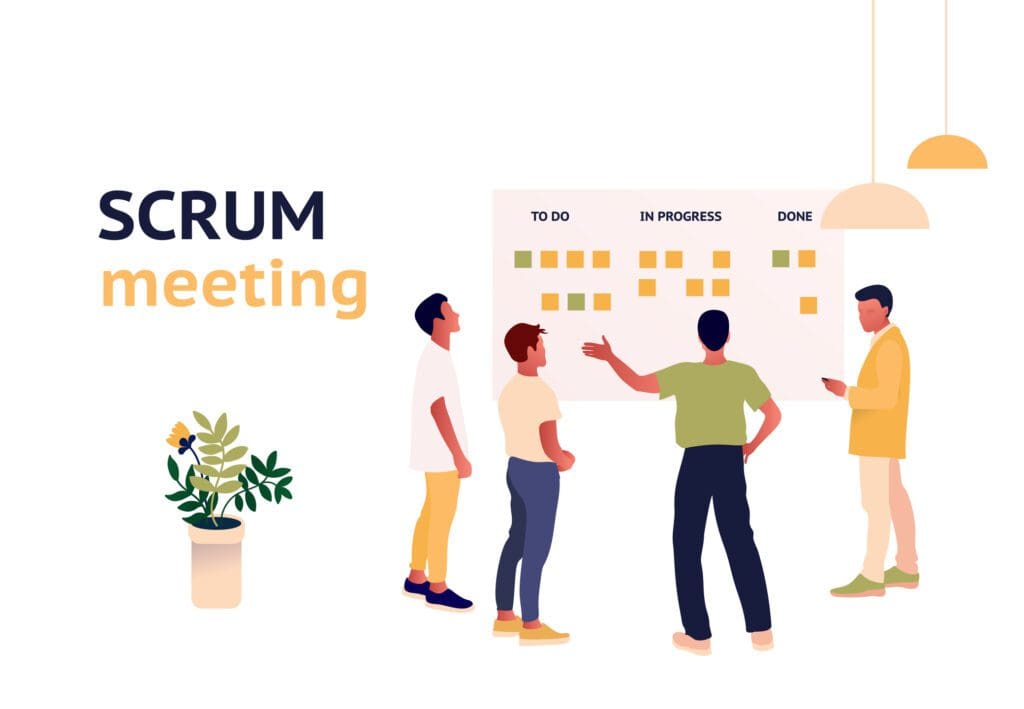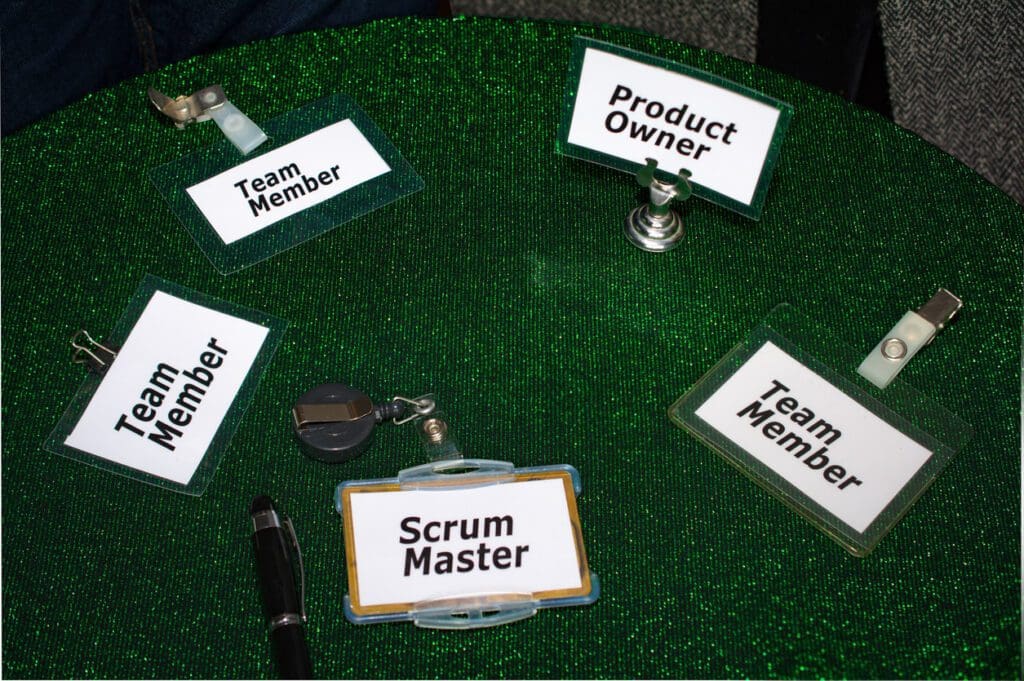Table of Contents
Product Owner vs. Scrum Master: Agile Roles & Differences
Scrum is an agile project management framework that is used to manage software development projects. It is a lightweight framework designed to help teams deliver products quickly and efficiently.
The Scrum Master and the Product Owner are two key roles in Scrum. The Scrum Master facilitates the Scrum process, while the Product Owner is responsible for the product vision and backlog. Some of the most popular agile frameworks include Scrum, Kanban, and Extreme Programming (XP).
In this blog, we will talk about the difference between Scrum Masters and Product Owners. These are two key roles in Scrum, and they play an important part in ensuring the team succeeds.
If you’re interested in learning more about Scrum or thinking about becoming a Product Owner or Scrum Master, we hope you’ll find this blog helpful.
What is Scrum?
Scrum is an agile project management framework that is used to manage software development projects. It is a lightweight framework designed to help teams deliver products quickly and efficiently. Scrum teams are self-organizing and cross-functional, working together to deliver the product.
Principles of Scrum
Scrum is based on the following principles:
- Iterative development: Scrum teams work in short iterations, called sprints, to deliver working software. This allows the team to get feedback from the customer early and often, which helps ensure that the product meets the customer’s needs.
- Customer collaboration: The Scrum team works closely with the customer to ensure the product meets their needs. The customer is involved in the product development process throughout, and they can provide feedback at any time.
- Transparency: Scrum teams are transparent about their work. The team shares their progress with the customer and the rest of the organization. This transparency helps build trust and ensures everyone is on the same page.
- Inspection and adaptation: Scrum teams inspect their work regularly and adapt their process as needed. This allows the team to improve their effectiveness and deliver better products.
What is Scrum Master?
The Scrum Master is a servant-leader who helps the Scrum Team self-organize and improve their effectiveness. The Scrum Master does not tell the team what to do but helps them find their way to success.


Responsibilities of the Scrum Master
Ensuring that the team follows the Scrum framework. This includes teaching the team about Scrum, coaching the team on Scrum practices, and removing impediments to the team’s progress.
Helping the team to self-organize. This includes helping the team to create a process that works for them, to resolve conflicts, and to make decisions.
Coaching the team on Scrum practices. This includes teaching the team about Scrum ceremonies, such as the daily standup and the sprint retrospective, and helping the team to apply Scrum principles, such as empiricism and continuous improvement.
Removing impediments to the team’s progress. This includes identifying and addressing issues preventing the team from working effectively, such as technical, process, or organizational problems.
Promoting Scrum within the organization. This includes educating the organization about Scrum, advocating for Scrum, and helping the organization adopt Scrum.
The Scrum Master should have the following skills and qualities
- Communication skills
- Problem-solving skill.
- Coaching skills
- Leadership skills
- Empathy
- Patience
The Challenges of Being a Scrum Master
The Scrum Master is not a manager. The Scrum Master does not have the authority to tell the team what to do. Instead, the Scrum Master must work with the team to help them find their own way to success.
The Scrum Master is responsible for removing impediments. This can be challenging, as it often requires the Scrum Master to work with people outside the Scrum Team.
The Scrum Master must be patient. The Scrum Master must be patient with the team as they learn and grow.
The rewards of being a Scrum Master
Helping the team to succeed. The Scrum Master can take great satisfaction in helping the team to succeed.
Learning and growing. The Scrum Master has the opportunity to learn and grow as they work with the team.
Making a difference. The Scrum Master can make a real difference in how software is developed.
What is a Product Owner?
The Product Owner is responsible for the product vision and the product backlog. This includes owning the product vision, managing the product backlog, prioritizing the backlog, working with the team to ensure that the team is working on the right things, and aligning the product with the business goals.
The Product Owner is the voice of the customer on the Scrum team. The Product Owner works with the customer to understand their needs and to translate those needs into a product vision. The Product Owner then works with the team to turn the product vision into a product backlog, a list of features the team will build.
Responsibilities of the Product Owner
Owning the product vision. The Product Owner is responsible for ensuring that the product meets the needs of the customer.
Managing the product backlog. The Product Owner is responsible for ensuring that the product backlog is prioritized and that the team is working on the right things.
Prioritizing the product backlog. The Product Owner is responsible for prioritizing the product backlog based on the needs of the customer and the business.
Working with the team to ensure that the team is working on the right things. The Product Owner is responsible for working with the team to ensure that the team is working on the most important things to the customer and the business.
Aligning the product with the business goals. The Product Owner is responsible for ensuring that the product is aligned with the business goals.
The Product Owner should have the following skills and qualities
- Communication skills
- Problem-solving skills
- Prioritization skills
- Collaboration skills
- Business acumen
Challenges of Being a Product Owner
The Product Owner is not a manager. The Product Owner must be able to tell the team what to do. Instead, the Product Owner must work with the team to help them find their own way to success.
The Product Owner is responsible for the product vision. The Product Owner is responsible for ensuring that the product meets the needs of the customer. This can be a challenging task, as it requires the Product Owner to understand the customer’s needs and translate those needs into a product vision.
The Product Owner is responsible for prioritizing the product backlog. The Product Owner is responsible for prioritizing the product backlog based on the needs of the customer and the business. This can be a challenging task, as it requires the Product Owner to understand the needs of the customer, the business, and the team.
The Product Owner must be able to collaborate effectively with the Scrum Team, the Scrum Master, and the rest of the organization. This can be a challenging task, as it requires the Product Owner to communicate effectively with various people.
Rewards of being a Product Owner
Helping the team to succeed. The Product Owner can take great satisfaction in helping the team to succeed.
Learning and growing. The Product Owner has the opportunity to learn and grow as they work with the team.
Making a difference. The Product Owner can make a real difference in how software is developed.
Difference between Product Owner and Scrum Master
- Role Focus: The primary duty of the product owner is to speak for the consumer and guarantee that the product satisfies their requirements. They decide what gets created, establish requirements, prioritize, and manage the product backlog. On the other side, the scrum master is concerned with facilitating the scrum process and eliminating any barriers that can delay the development team. They make sure the team adheres to the values and procedures of Scrum.
- Customer Interaction: The product owner frequently interacts with users, stakeholders, and consumers to learn about their needs, get input, and convey the product’s vision. Despite being active in communication, the scrum master places a greater emphasis on fostering teamwork and fostering a constructive work environment.
- Decision Making: The product owner can decide on the product, including prioritizing tasks, accepting or rejecting work-related outcomes, and determining trade-offs based on user needs and company value. On the other hand, the scrum master cannot make decisions regarding the product. They have the responsibility of assisting the team in making decisions.
- Backlog Management: The user stories in the product backlog are prioritized by the product owner, who also oversees the requirements and ensures the items are clear and prepared for development. The team’s comprehension and effective use of the backlog is the scrum master’s primary concern; they do not manage it.
- Team Support: The development team’s coach and facilitator is the scrum master. They aid the group in fostering self-organization, ongoing development, and adherence to agile concepts and procedures. While working with the team, the product owner is not in charge of overseeing their daily operations.
- Sprint Planning: To share information about the priorities and requirements for the product, the product owner actively participates in sprint planning meetings. By working with the team, they decide which backlog items will be tackled in the future sprint. The scrum master oversees the team’s adherence to the established procedure and organizes the sprint planning meeting.
- Daily Scrum: The daily scrum meetings are facilitated by the scrum master, who makes sure they are time-boxed and relevant discussion-focused. They support the team in identifying and removing any obstacles. The product owner may attend the daily scrum, but he or she is not in charge of organizing or running it.
- Stakeholder Engagement: The product owner interacts with stakeholders to get input, give updates on the development, and control expectations for the product. To ensure that the alignment meets their needs, they actively solicit stakeholder input. The scrum master does not share the obligation to engage stakeholders.
- Product Vision: Defining and communicating the product vision falls to the product owner. They ensure the development team understands the product’s overarching goals and objectives. Although it is not their primary duty, the scrum master assists the product owner in articulating and communicating the vision.
- Metrics and Reporting: Product success measures, including user engagement, customer satisfaction, and business value, may be tracked and analyzed by the product owner. They follow these data and utilize the information to inform their product choices. The scrum master’s primary focus is usually on assisting the team in using agile metrics, such as sprint burndown charts or team velocity, in enhancing performance.
| Aspect | Product Owner | Scrum Master |
| Role Focus | Represents the customer and product vision | Facilitates the Scrum process |
| Customer Interaction | Close interaction with customers and stakeholders | Focus on team collaboration and productivity |
| Decision Making | Authority to make product-related decisions | Facilitates decision-making within the team |
| Backlog Management | Owns and manages the product backlog | Does not manage the backlog directly |
| Team Support | Collaborates with the team | Coaches and facilitates team activities |
| Sprint Planning | Actively participates in sprint planning meetings | Facilitates the sprint planning process |
| Daily Scrum | May attend but not responsible for leading or managing it | Facilitates the daily scrum meetings |
| Stakeholder Engagement | Engages with stakeholders for feedback and updates | Less involved in stakeholder engagement |
| Product Vision | Defines and communicates the product vision | Supports the product owner in vision clarity |
| Metrics and Reporting | Involved in tracking product success metrics | Facilitates the use of agile metrics |
Similarities between Product Owner vs. Scrum Master
Essential to the success of a Scrum team. The product owner is responsible for the product vision and backlog, while the scrum master is responsible for ensuring that the team follows the Scrum framework and removes impediments to the team’s progress.
Work closely with the Scrum team. The product owner works with the team to prioritize the product backlog and ensure that the team works on the right things. The scrum master works with the team to help them self-organize and to improve their effectiveness.
Focused on the success of the product. The product owner is focused on ensuring that the product meets the needs of the customer and the business. The scrum master is focused on ensuring the team delivers the product on time and within budget.


Conclusion
The product owner is responsible for the product vision and the product backlog. This includes owning the product vision, managing the product backlog, prioritizing the backlog, working with the team to ensure that the team is working on the right things, and aligning the product with the business goals.
The scrum master is a servant-leader who helps the Scrum Team self-organize and improve their effectiveness. The scrum master does not tell the team what to do but helps them find their way to success.
In conclusion, the scrum master and product owner are two key roles in Scrum, an agile project management methodology. Both roles are essential to a Scrum team’s success, but they have different responsibilities and focus on different aspects of the project.



